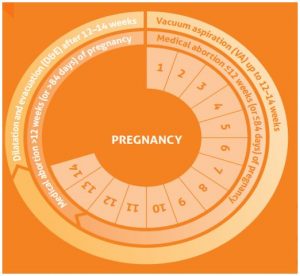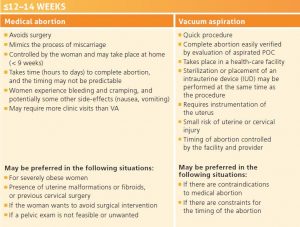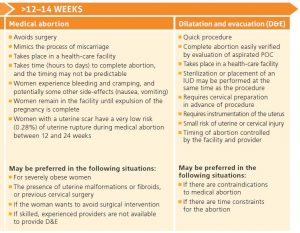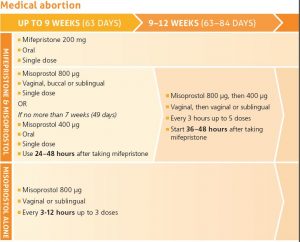
Safe abortion:
- Abortion is the termination of pregnancy by removing the fetus from mother’s womb which may be spontaneous or induced before 20th week of gestation period or when fetus is less than 500gm of birth weight. However, this defined week/gestational period for safe abortion can vary from country to country and sometimes even in between the states of the countries.
- Abortion is regarded as safe if it is conducted by trained and skilled personnel and carried out in safe, clean environment and also conforms to medical standards such as use of sterilized instruments, maintaining proper hygiene and sanitation etc.
- An abortion is called safe when it carried out:
- By trained and skilled health worker
- With sterilized instruments. Anything that goes into the vagina should be sterile (without any germs)
- Hygiene and sanitation should be attained
- Within 12 weeks of pregnancy
- According to WHO reports, 92% abortions carried out in developed countries are safe but on contrast about 55% abortions are unsafe in developing countries.
Methods of safe abortion:
- Surgical abortion
- It is method of abortion that involves operation procedure.
- Two types of operations (i.e. Vacuum aspiration & Dilation and evacuation) can be used in surgical abortion.
- Vacuum aspiration can be done up to 14 week of pregnancy and Dilation and evacuation is mainly carried out for pregnancies between 15-24 weeks
- Medical abortion
- Medical abortion is a method for abortion in which medicines/ drugs are used for terminating pregnancy.
- It is also referred as “non-surgical abortion”.
- Combination of Mifepristone and Misoprostol drugs are used for conducting abortion. It is applicable up to 7 to 9 week of pregnancy.
Safe and unsafe time for abortion:
- Abortion is considered safer in early weeks of pregnancy; 5-7 week of pregnancy is safe to health as suggested by health professional. As fetus is growing day by day, abortion becomes more risky.
- Unsafe time for abortion is when a woman is more than three months pregnant. Longer the time of being pregnant greater is the risk from abortion. After 12 weeks or 3 months abortion should be carried out in hospital or clinics where all necessary equipments are available.
International guidelines and protocols for safe abortion:
- In international scenario, unsafe abortion is a major issue that is responsible for woman’s death.
- ICPD (International Conference on Population and Development) held in Egypt in 1994 recognized access to safe abortion as priority need for improving the health of women.
- In recent times, abortion has been legalized in many countries under certain circumstances.
- According to World abortion policies 2013, it was found that out 196 countries, 190 countries have legalized abortion to save women’s life, 99 countries have legalized abortion only in rape case, and 58 states permit abortion on request.
- WHO has published a book titled, “Safe abortion: technical and policy guidance for health systems” which is the 2nd It is evidence-based document which is utilized by different countries for making national guidelines, clinical protocols and bring reforms in abortion policies and laws.
WHO Recommendation for medical and surgical abortion method:

Characteristics of different abortion procedures at different gestational age:


In summary, methods of medical and surgical abortion at different gestational age can be understood from the table below:
Medical Abortion:

Surgical Abortion:



Precautions to be taken for infection prevention and control during Abortion:
1. Hand washing
- Hand should be washed with soap and water before and after contact with the patient and other contaminated item.
- Gloves should be worn before coming in contact with the client and should be replaced while checking another client, also while carrying out different vaginal examination of same woman. Health personnel should also wash their hand after examining one client as gloves may have hole in it.
2. Use of protective equipment
- Equipments such as gloves, mask, apron, protective eyewear and footwear should be used by the service provider while giving abortion service.
3. Antiseptics
- Woman’s cervix should be cleaned with antiseptic i.e. betadine before carrying out surgical procedure.
4. Handling and disposal of the instruments
- Sharp instruments such as blades and needles should be properly handled and disposed.
- All instruments and material should be properly handled.
Positive effect of safe abortion on woman’s health and progress:
- Safe abortion protects woman life and health conditions in rape case.
- Helps to minimize unintended pregnancy as counseling on contraception and services along with access to comprehensive sex education is provided.
- It protects women from infectious disease.
- Protects women life from problem/complications arising from unsafe abortion.
- Reduced maternal mortality and morbidity due to unsafe abortion.
- Protects women from violence: pregnancy before marriage is not accepted in certain cultures and society as a result, women may be subjected to physical violence or may be killed.
- Legalized access to safe abortion empowers women to take decision about their own childbearing and will also have positive effect on mental health.
- A woman may have unwanted pregnancy and may be too young to bear and take care of child. In such situation access to safe abortion can be a great help, woman may have higher dreams to achieve or carrier goals and may do so if she has access to safe abortion.
References and for more information:
https://www.mariestopes.org.au/abortion/
https://www.slideshare.net/namratagupta96780/safe-abortive-services-in-nepalsas
http://apps.who.int/iris/bitstream/10665/70914/1/9789241548434_eng.pdf
http://apps.who.int/iris/bitstream/10665/173586/1/WHO_RHR_15.04_eng.pdf
http://apps.who.int/iris/bitstream/10665/97415/1/9789241548717_eng.pdf
http://asap-asia.org/blog/lakshmi-dhikta-v-nepal-a-far-reaching-decision/#sthash.oM1qCSD5.dpbs
https://www.reproductiverights.org/sites/default/files/documents/nepal_2002.pdf
https://www.ippf.org/news/breaking-silence-abortion
https://en.wikipedia.org/wiki/Abortion
http://americanpregnancy.org/unplanned-pregnancy/medical-abortions/
https://www.bpas.org/abortion-care/abortion-treatments/surgical-abortion/
http://en.hesperian.org/hhg/Where_Women_Have_No_Doctor:Safe_Methods_of_Abortion
https://wealthformyhealth.com/abortion-time-period/
http://www.sida.se/globalassets/sida/sve/sa-arbetar-vi/safe_abortions.pdf
http://apps.who.int/iris/handle/10665/244147
https://www.ncbi.nlm.nih.gov/books/NBK138197/
Author for this article: Ms. Rojina Tandukar. Ms. Tandukar is pursuing her degree in Public Health from a reputed University.